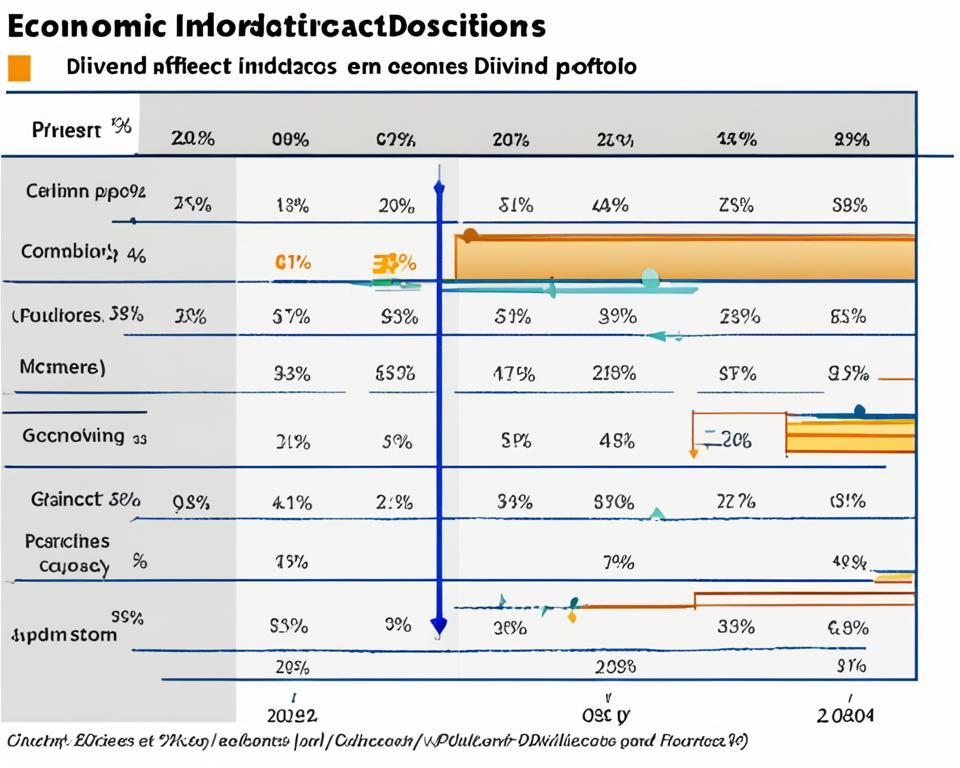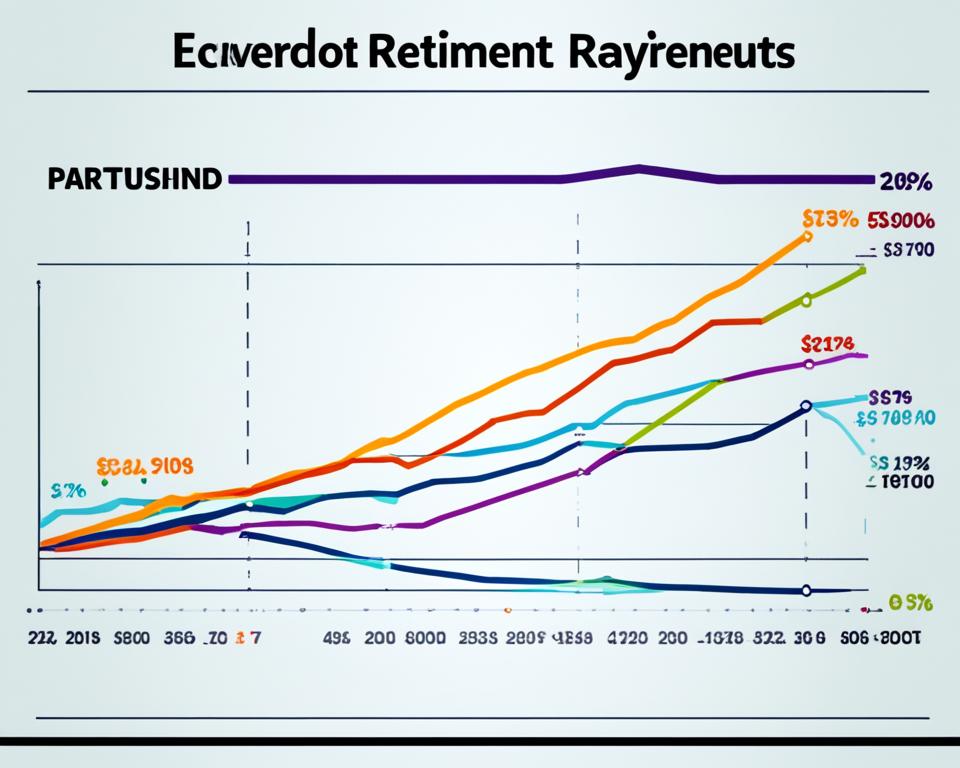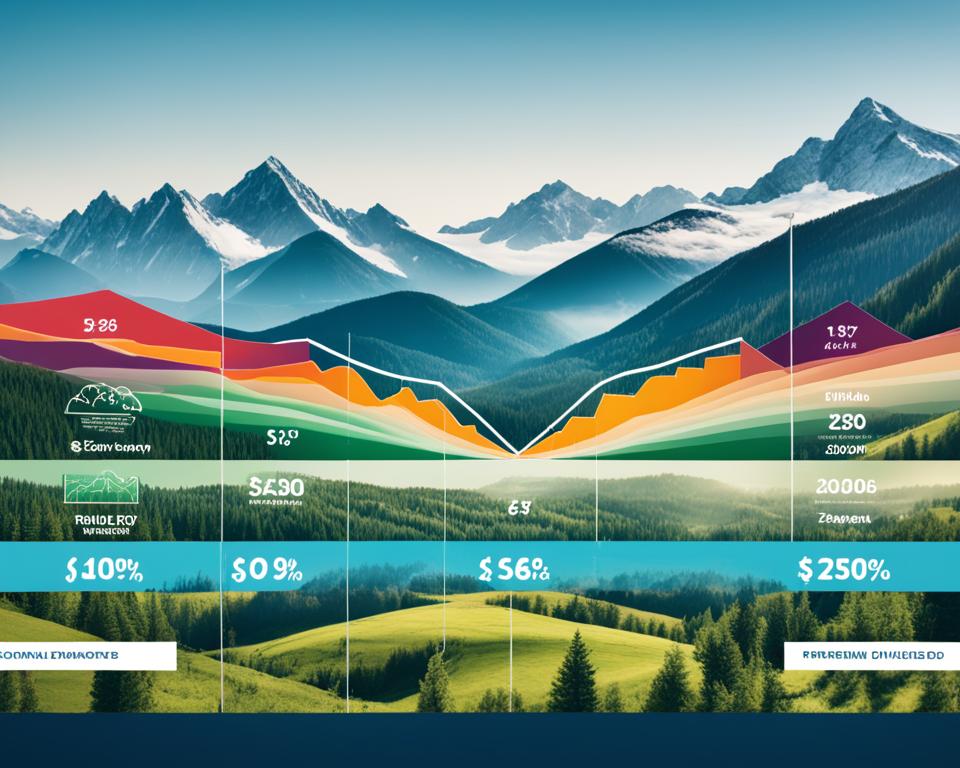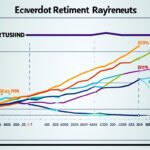Investing isn’t merely about buying low and selling high. A thoughtful and strategic investor analyzes multiple factors, including economic indicators and market trends, in making dividend portfolio decisions. As we delve into the intricacies of these decisions, we find that dividends not only supplement investment profits but also serve as a crucial metric in fundamental analysis. They help investors broaden their risk perspective, leverage tax benefits, and safeguard the purchasing power of their capital against inflation.
Dividend issuance mirrors the sound financial health of a company, acting as a barometer of a company’s real cash flow. Contrasting other financial metrics that likely succumb to accounting maneuvers, dividends serve as a more reliable indicator. What’s more, dividends historically have had a growth trajectory even during recessions. This is evident in data from the S&P 500 returns from 1980 to 2019, where dividends constituted a significant chunk of returns.
Key Takeaways
- Dividends significantly enhance stock investing profits and influence dividend portfolio decisions.
- They offer an additional metric for fundamental analysis, aiding investors in making informed decisions.
- Dividends counterbalance portfolio risk and avail superior tax advantages.
- They help sustain the purchasing power of capital, warding off inflationary impacts.
- Dividend issuance is reflective of a company’s robust financial standing, providing insights into its real cash flow.
- Historically, dividends have grown during recessions, highlighting their stability in market volatility.
The Significance of Dividends in Investment Returns
Dividends, as a significant aspect of investment gains, often don’t get the spotlight they deserve. Yet, they provide a powerful mechanism to generate income and help in long-term dividend yield optimization. Understanding the role of dividends in complementing the capital gains from stocks is integral to building a balanced investment strategy.
Contribution of Dividends to Stock Market Profits
The power of dividends in enhancing stock market trends is not to be underestimated. Between 1980 and 2019, 75% of the returns from the S&P 500 were from dividends. The dividends that investors receive are generally reinvested, contributing significantly to the overall growth of the investment portfolio.
Dividend vs. Fixed-Income Investments in Low-Interest Rate Environments
In an era of low-interest rates, dividends can become a compelling income source outperforming most fixed-income investments, such as government bonds. Amid slim returns elsewhere, stocks from financially sound companies offering high dividends become very attractive.
Stock Price Stability and Attractiveness Linked to Dividend Declarations
Dividends do play a considerable role in enhancing a stock’s attractiveness. When a company commits to making regular dividend payments, it demonstrates certain solidity and trustworthiness. These declarations, particularly amongst renowned “dividend aristocrats” who have consistently increased their payouts, signal evidence of growth and expansion of profits.
| Event | Impact on Stock Market |
|---|---|
| Interest Rate Drop | Boosts dividend yield optimization through increased demand for higher yield stocks |
| Regular Dividends Declaration | Enhances the attractiveness and demand for the stock, potentially raising its market value |
| Dividend Increment among “Dividend Aristocrats” | Offers evidence of growth and consistent financial performance moving beyond market trends |
To summarize, dividends do not just offer a steady stream of income but also contribute towards a company’s stability and growth in the eyes of the investment community. Incorporating these dividends in your investment strategy and gauging them using suitable financial performance metrics is a step towards building more profitable and resilient portfolios.
Dividends as Metrics for Evaluating Company Health
Facing a dynamic landscape of economic indicators and high-stock market volatility, investors increasingly turn to dividends for an impartial assessment of a company’s financial health. Unlike other financial performance metrics, dividends offer a concrete dimension to a company’s real cash value, providing meaningful insights that extend well beyond the observable stock prices. In fact, consistently growing dividends are often regarded as a testament to a company’s profitability and potential for growth.
Assessing Real Cash Flow and Financial Standing through Dividend Payouts
From an investor’s perspective, dividend payouts provide a tangible insight into a company’s real cash flow, which often forms the basis of investment decisions. This is especially relevant considering that many financial performance metrics are easily susceptible to variations in a company’s accounting practices. Infusing reliability and transparency into the market analysis, dividend payments often serve as a key indicator of a company’s fiscal health.
Historical and Predictive Value of Dividend Trends
A consistent dividend payment history enables investors to gauge a company’s capacity to generate profits over time. More than just a reflection of past performances, growing dividends carry predictive value indicating a firm’s potential for future growth and profitability. In effect, the stability dividends bring to equity evaluation is a hallmark of companies that traditionally maintain or increase dividend payments, thereby showcasing a sound financial position.
To sum up, dividends play a pivotal role in evaluating a company’s fiscal health and future growth prospects. In a volatile market environment, they provide a steady and dependable benchmark for investors, enabling them to make informed decisions and optimize their investment strategy.
Fiscal Strength and Dividend Announcements
The financial market responds to a variety of signals, with data often interpreting how potential and current investors make key portfolio decisions. One such powerful indicator is the declaration of a company’s first dividend, which signifies its fiscal maturity and robust economic standing. This is swiftly recognized by the market, often triggering a favorable response tied to stock performance, and thus having significant impact on dividends.
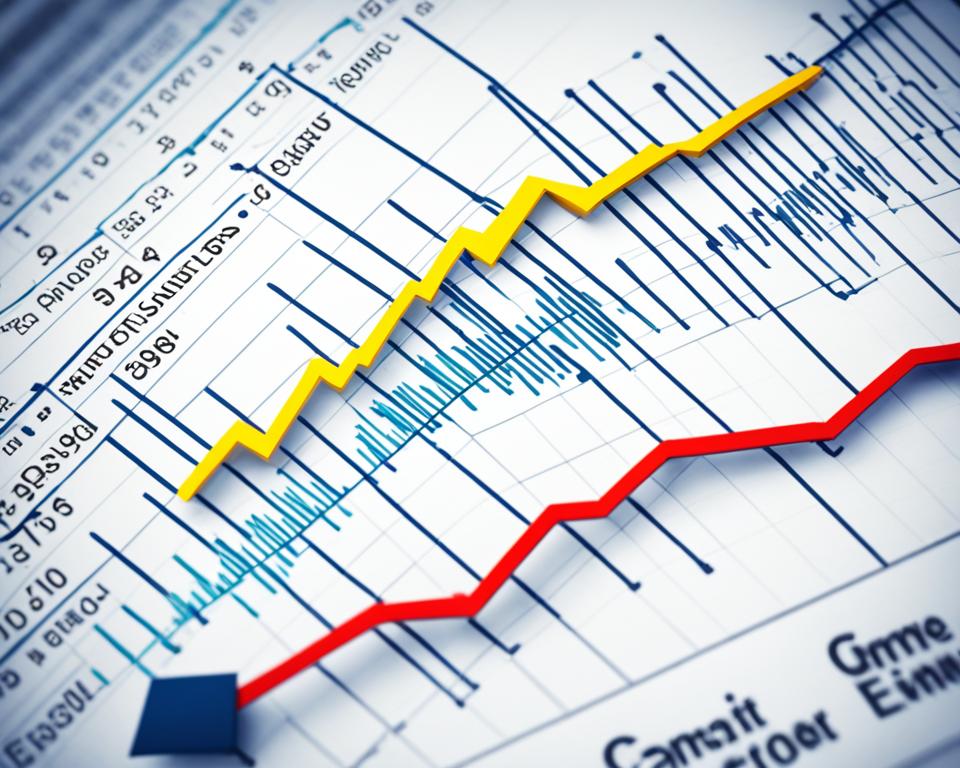
First Dividend Payment as a Milestone of Fiscal Maturity
The initiation of dividend payments serves as an important milestone in a company’s growth journey. It is indicative of the company’s ability to generate enough profits to share with its shareholders, and not only reinvest in its operations. It is also perceived as an affirmation of the company’s fiscal maturity and comprehensive financial strength. For investors, this can be a reliable gauge when making dividend portfolio decisions.
Impact of Inaugural Dividend Payments on Stock Performance
Historical data reveals compelling insights into the effect of a company’s first dividend declaration on its stock performance. In many instances, these companies have outperformed the S&P 500 Index in the year following their inaugural dividend announcement. Having an inaugural dividend is often viewed as a positive signal by investors, reflecting quality cash flows and promising future dividends. This market recognition underscores current stock market trends, where a demonstrated financial resilience adds attractiveness to dividend-paying stocks.
| Year | Number of Companies Declaring First Dividends | Average Stock Performance Following First Dividend Declaration (%) |
|---|---|---|
| 2015 | 5 | 9.2 |
| 2016 | 7 | 8.7 |
| 2017 | 10 | 7.6 |
| 2018 | 8 | 10.1 |
| 2019 | 6 | 11.3 |
| 2020 | 4 | 8.5 |
Dividends and Market Volatility: Navigating Economic Cycles
Equity markets exhibit cyclical behaviors, reflecting the ebb and flow of economic cycles. Amid these cycles, dividends can become a comforting beacon for investors. Dividend-paying stocks have historically offered a sense of stability and resilience, significantly aiding in reducing portfolio risk and navigating through market volatility. Let’s delve a bit deeper into this aspect of financial strategy.
Dividend Payers’ Performance During Bear Markets
During bear market periods characterized by falling stock prices and negative investor sentiment, dividend payers have frequently outperformed their non-dividend paying counterparts. The steady income from dividends can cushion the fall in stock prices, resulting in a smaller drop in the total value of such investments. For instance, during the financial crisis of 2008/2009, companies with robust and growing dividends outperformed those with no dividends or cutting dividends.
Dividend Stocks as a Buffer in Investment Portfolios
Reinforcing an investment strategy with dividend paying stocks can serve as an effective buffer against the economic downturns. Historically, these stocks have shown resilience against market volatility. A study by Merrill Lynch during the financial crisis of 2008 highlighted that dividend-paying firms experienced less volatility in their stock prices compared to non-dividend paying firms. Even in recent events, such as the financial disruption caused by the global coronavirus pandemic, the trend underline the stability and less volatile nature of dividend stocks.
This stability is owed to the continuous income stream generated by dividends that can help offset short-term market losses and provide cash flow during market downturns. Hence, dividend-paying stocks prove instrumental in safeguarding investors’ capital during economic downturns, making them a prudent addition to any investment portfolio.
Tax Efficiency of Dividend Investing
Dividend investing is not only valuable because of the potential returns but also because of the tax advantages it presents. This section explores the fiscal benefits that qualified dividends offer, and how tax policies on dividends influence investor decision-making, shaping overall investment strategies.
Qualified Dividends and Lower Tax Rates
One significant benefit of investing in dividends is their tax efficiency. Specifically, qualified dividends, which meet specific criteria determined by the IRS, are subject to lower tax rates than ordinary income. This distinction can have a considerable impact on an investor’s net return.
- High earners are subjected to a tax rate of 20% on their qualified dividends.
- People in the lower income brackets may enjoy a tax rate on their qualified dividends as low as 0%.
The categorization of dividends as qualified or not relies on the holding period of the stocks and the type of dividend. These are important considerations in shaping one’s investment strategy.
Impact of Dividend Taxation on Investor Decision-Making
The taxation of dividends, particularly the more favorable rates applied to qualified dividends, can significantly impact investor behavior. Investors often adjust their strategies, investing more in companies offering qualified dividends. This is predicated on their understanding of tax advantages and how maximizing these can optimize investment returns.
The tax efficiency of dividend income, compared to other forms of investment income, can cause a paradigm shift. It can potentially transition an investor’s focus from purely capital gains to a balanced approach that prioritizes both capital gains and income.
In conclusion, the tax advantages associated with dividend investing make it a compelling element of any robust investment strategy. Understanding the intricacies of qualified dividends and their tax implications can boost net investment returns and equip investors to make informed decisions that optimize their portfolios.
Preservation of Purchasing Power through Dividends
As the world economy evolves, investors strive to preserve or increase their purchasing power amid shifting inflation rates. An investor’s purchasing power represents their capacity to buy goods and services, a figure which invariably gets eroded by inflation over time. This next part of our discourse will illustrate how dividends can play a pivotal role in combating inflation and bolstering purchasing power.
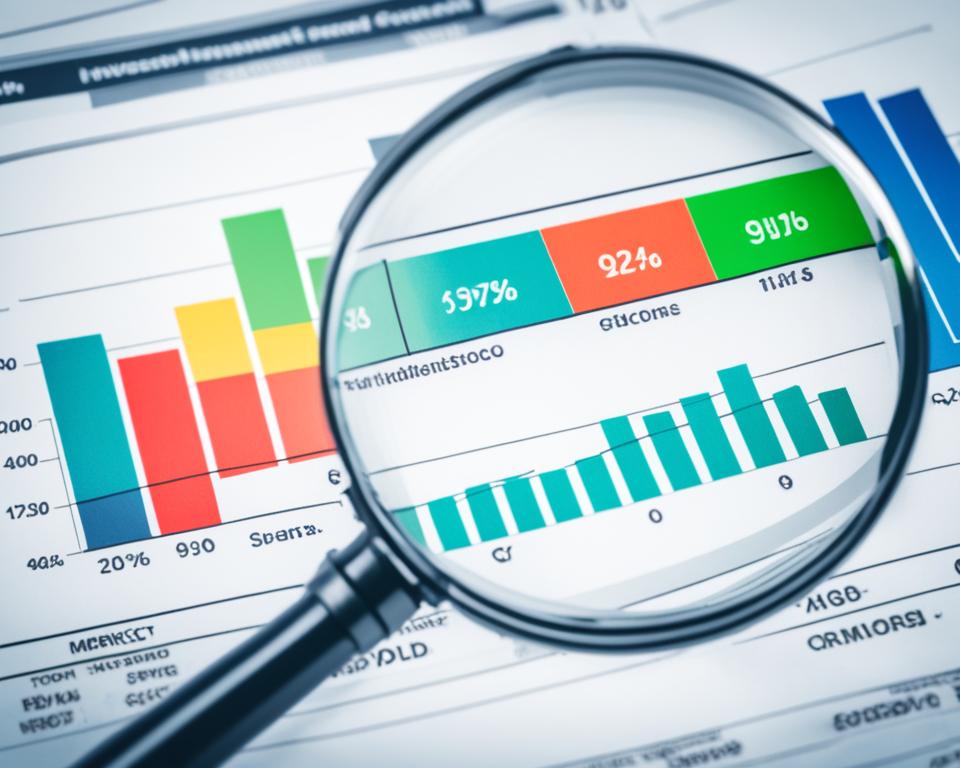
Combatting Inflation with Dividend Yields
Inflation is a steady increase in the prices of goods and services. It is an economic phenomenon that reduces purchasing power as the same amount of money buys fewer items over time. However, dividend yields can serve as a powerful tool to combat inflation. Often, the returns from dividend-paying stocks outpace the rate of inflation, preserving an investor’s purchasing power. In certain cases, the yield on these stocks may exceed the inflation rate, leading to real gains in capital.
This advantage underscores the pivotal role of dividends in mitigating the cost of living increases.
Real Return Accounting for Inflationary Pressures
Apart from dividend yields, another essential component of investing is a concept known as the real return. The real return is essentially the annual percentage return realized on an investment, adjusted for changes in prices due to inflation. It reflects the purchasing power of the amount of money that one has invested in an asset. By investing in dividend-yielding stocks, investors can, to an extent, safeguard their investments against the erosion of purchasing power due to inflation.
Stocks that offer both capital appreciation and a stable dividend yield can provide actual positive returns on investments. Even when factoring in inflation, a robust dividend yield can offer a cushion against economic volatility and a tangible means to preserve — and in some cases, enhance — purchasing power. As such, savvy investors understand the importance of incorporating dividend yields within their broader optimized investment strategies.
Influence of Economic Indicators and Market Trends Impact Dividend Portfolio Decisions
Amid the fluctuations of the financial world, sound investment strategy relies heavily on interpreting economic data. Bracing against recessions, maximizing profits, and positioning for growth all hinge on understanding the economic indicators and market trends that molds our financial landscapes.
Interpreting Economic Data for Dividend Investment Strategies
In the past, robust economic data such as improvements in the Q4 GDP, surges in consumer spending, favorable labor market data, and optimistic PMI readings have prompted investors to adjust their dividend portfolios. These indicators serve as signs of growing economic resilience, suggesting the potential to avoid recessions and enhance earnings expectations.
Market sentiments also play a vital role in economic data analysis. Investor behavior can significantly shift based on expectations of interest rate cuts or rising geopolitical tensions. Therefore, it becomes incumbent on investors to align their dividend portfolios with these prevailing market trends and conditions.
Adjusting Dividend Portfolios to Reflect Market Sentiment
Understanding that economic indicators and market trends are intertwining pieces of a complex puzzle can help fine-tune investment strategies and dividend portfolio decisions. For instance, a thriving economy might inspire investor confidence, encouraging an increase in investment in high dividend-yielding stocks.
On the other hand, during a downturn, investors might gravitate towards companies with a robust track record of stable dividend payouts. These subtle shifts in market sentiment make a significant difference in crafting a profitable and resilient dividend portfolio.
| Economic Indicator | Market Trend | Impact on Dividend Portfolio |
|---|---|---|
| Improvements in Q4 GDP | Economic growth | Increased investment in high dividend stocks |
| Rising consumer spending | Upbeat market sentiment | Focus on stocks with potential for dividend growth |
| Favorable labor market data | Enhanced economic resilience | Preference for companies with stable dividend payouts |
| Optimistic PMI readings | Anticipation of booming industry | Selection of sector-specific dividend stocks |
Investment Strategy: Balancing Dividend Reinvestment and Payout Ratios
One of the critical aspects to consider when investing in dividend-paying companies is the strategy between dividend reinvestment and high payout ratios. The ultimate goal for investors is total return, and the approach to achieving this can vary depending on the specific company and sector.
Understanding the Significance of Reinvestment in Growth Sectors
Companies operating in growth sectors might prioritize reinvestment of profits over payout to shareholders. This strategy is typically employed to drive innovation and establish a strong competitive position in the market. In these scenarios, the investor’s gain is primarily capital appreciation, reflecting the company’s growth over time as economic indicators improve.
Evaluating Payout Ratios in Relation to Company Profits and Growth
Conversely, established firms often highlight their financial stability through consistent dividend growth. This is particularly attractive for investors focussed on regular income streams, despite potentially slower company growth. The payout ratio – the proportion of earnings paid out as dividends to shareholders – becomes a critical metric for these investors. A higher payout ratio might indicate a company’s strong financial position and its ability to return profits to its investors.
To illustrate, consider the following table showing the payout ratio and annual growth of two hypothetical companies:
| Company | Payout Ratio | Annual Growth |
|---|---|---|
| Company A | 35% | 15% |
| Company B | 75% | 5% |
Company B has a higher payout ratio, implying a larger proportion of its earnings is distributed as dividends. This could potentially mean stable returns for investors seeking consistent dividend income. On the other hand, Company A, with a lower payout ratio, might be retaining more of its earnings for reinvestment into growth and innovation efforts.
The economically driven choice between reinvestment and high payout ratios is crucial in striking a balanced investment strategy. It ultimately relies on the investor’s specific financial goals, risk tolerance, and the individual company’s growth trajectory.
Conclusion
In the investment world, careful strategy and informed decisions are essential. In this context, it becomes critical to understand the impact of major economic indicators and evolving market trends on dividend portfolio decisions. Likewise, embracing an investiture strategy that integrates these two elements can spearhead the dual pursuit of yield optimization and risk minimization.
Integrating Economic and Market Analysis for Dividend Portfolio Optimization
An insightful blend of economic and market trend analysis proves to be significantly impactful when making dividend portfolio decisions. Such a strategy not only caters to optimizing dividend yield but also effectively minimizes the inherent investment risk in the volatile marketplace. The interpretation of these trends guides investors towards asset allocations that demonstrate both market resilience and promising yield prospects.
The Role of Dividend Stocks in a Balanced and Forward-Looking Portfolio
Long-term performance of dividend-paying companies, especially those demonstrating a consistent growth in dividend declaration, can provide a strong foundation for balanced and forward-looking portfolios. Investing in such companies positions portfolios to withstand market cyclicity while ensuring a steady stream of income through dividends. Steering investments in the direction of companies boasting robust financial health and sustainable dividend policies can significantly contribute to achieving both capital appreciation and investment income.
In essence, business acumen paired with carefully analyzed market insights can lead to rewarding investment experiences, especially when decision-making leans on economic indicators and market trends. A forward-thinking and balanced investment approach, underpinned by a sound dividend investment strategy, is undoubtedly an asset to succeed in the dynamic investment landscape.
FAQ
How do economic indicators and market trends impact dividend portfolio decisions?
Economic indicators such as GDP, consumer spending, labor market data and PMI can influence investors’ dividend portfolio decisions. For example, signs of economic resilience can enhance earnings expectations and suggest potential avoidance of recession. Similarly, market sentiments such as interest rate cut expectations and geopolitical developments can influence portfolio decisions. Understanding how these factors influence dividends can help investors optimize their dividend yield and minimize risk.
How do dividends contribute to stock market profits?
Dividends can significantly enhance stock investing profits. From 1980 to 2019, 75% of the returns from the S&P 500 came from dividends. Furthermore, in low-interest rate environments, dividend yields from dividend-paying companies can be substantially higher than those from most fixed-income investments.
How do dividends impact the financial health of a company?
Dividend payouts can offer a tangible assessment of a company’s real cash flow and its underlying financial health. Consistently growing dividends serve as an indication of a company’s profitability and growth, offering insights beyond the fluctuating stock prices. Therefore, analyzing dividends can provide valuable insights into a company’s financial position.
What is the impact of inaugural dividend payments on companies’ stock performance?
The initiation of dividend payments is often seen as a testament to a company’s fiscal maturity and financial strength. Based on historic data, companies announcing their first cash dividends have typically outperformed the S&P 500 index in the following year. This trend underscores the positive response from the market towards companies that pay dividends.
How can dividends help investors navigate market volatility and economic cycles?
Dividend-paying stocks can help mitigate overall portfolio risk and market volatility. Historically, such stocks have outperformed non-dividend stocks during bear markets. Even in recent volatile scenarios, like during the coronavirus pandemic, dividend-paying stocks generally demonstrated stability, reducing portfolio risk and adding investment value.
How does the taxation of dividends influence investment decisions?
Dividends are tax-efficient with qualified dividends facing lower tax rates than ordinary income. This tax advantage varies by tax bracket but gives an edge to dividend income over other forms of investment income. For high earners, qualified dividends are taxed at 20%, while lower brackets benefit from rates as low as 0%.
How do dividends help to preserve purchasing power?
Dividends can help to combat inflation and preserve the purchasing power of capital by providing investment returns that often outpace inflationary pressures. This is especially significant when the yield on dividend-paying stocks exceeds the rate of inflation.
How can economic data and market trends influence investment strategies in dividend investments?
Economic indicators combined with market trend analysis guide investors towards companies with strong balance sheets, sustainable dividend policies, and the potential to withstand market cycles. Utilizing economic data and understanding market trends helps investors adjust their dividend portfolios to reflect market sentiment, ultimately optimizing their investment strategy.
What is the significance of balancing dividend reinvestment and payout ratios in investment strategy?
The choice between reinvestment and high payout ratios is integral to investment strategies in dividend-paying companies. Depending on the company’s sector and growth stage, some might favor reinvestment over payouts to foster innovation, while others might prefer consistent dividend growth as a sign of financial stability, offering regular income for investors.
How can integrating economic and market analysis help in dividend portfolio optimization?
Thorough economic and market trend analysis can significantly impact dividend portfolio decisions, catering to the dual goals of dividend yield optimization and risk minimization. For a balanced and forward-looking portfolio, investors need to consider both the historical and prospective performance of dividend-paying companies and align them with prevailing market conditions.

